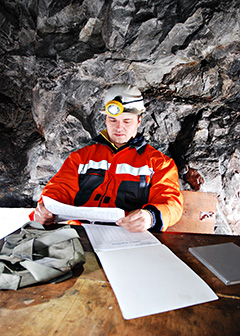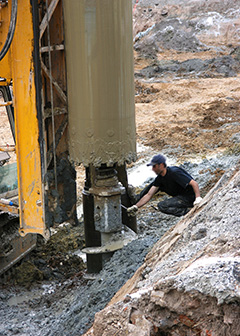How to Become a Mining or Geological Engineer About this section

A bachelor’s degree from an accredited engineering program is required to become a mining or geological engineer.
A bachelor’s degree from an accredited engineering program is required to become a mining or geological engineer, including a mining safety engineer. However, to work as a credentialed professional engineer requires licensure. Requirements for licensure vary by state but generally require passing two exams.
Education
Students interested in entering mining engineering programs should take courses in mathematics and science in high school.
Relatively few schools offer mining engineering programs. Typical bachelor’s degree programs in mining engineering include courses in geology, physics, thermodynamics, mine design and safety, and mathematics. They involve extensive laboratory and field work as well as traditional classroom study.
Programs in mining and geological engineering are accredited by ABET (formerly the Accreditation Board for Engineering and Technology). ABET accreditation is based on a program's faculty, curriculum, facilities, and other factors.
Master’s degree programs in mining and geological engineering typically are 2-year programs and include coursework in specialized subjects such as mineral resource development and mining regulations. Some programs require a written thesis for graduation.
Important Qualities
Decision-making skills. Mining and geological engineers do work that can affect not only companies’ profits but miners’ lives. The ability to anticipate problems and deal with them immediately is crucial.
Logical-thinking skills. In planning mines’ operations, mineral processing, and environmental reclamation, these engineers have to be able to put work plans into a coherent, logical sequence.
Math skills. Mining and geological engineers use the principals of calculus, trigonometry, and other advanced topics in mathematics for analysis, design, and troubleshooting in their work.
Problem-solving skills. Mining and geological engineers must explore for mines, plan the operations of mines, work out the mineral processing, and design environmental reclamation projects. These are all complex projects requiring an ability to identify goals and build plans to reach the goals while solving problems along the way.
Systems analysis. These engineers must consider the wider implications of their immediate work to plan for environmental reclamation, for example. They must be able to consider several competing, but interconnected, issues at the same time.
Writing skills. Other workers, including miners, must read what these engineers write. Therefore, they must be able to write clearly so that others can easily understand their thoughts and plans.
Licenses
In every state, engineers who offer their services directly to the public must be licensed in that state. The National Council of Examiners for Engineering and Surveying (NCEES) administers two exams for licensure for this occupation. The first covers the fundamentals of engineering (FE), the second the principles and practices of engineering (PPE). The FE exam can be taken upon graduation. Engineers who pass this exam are commonly called engineers in training (EITs) or engineer interns (EIs). After 4 years of relevant work experience, EITs can take the PPE exam.
Licensed engineers are called professional engineers (PEs).
Generally, licensure requires the following:
- A degree from an ABET-accredited engineering program
- 4 years of relevant work experience
- Successful completion of a state examination
In several states, engineers must take continuing education credits to keep their licenses. Most states recognize licenses from other states, provided that licensure requirements in the other states meet or exceed the first state’s own requirements.
Advancement
Beginning engineering graduates usually work under the supervision of experienced engineers. In large companies, engineers starting out also may receive formal classroom or seminar-type training. As new engineers gain knowledge and experience, they are assigned more difficult projects with greater independence to develop designs, solve problems, and make decisions.
Engineers may advance to become technical specialists or to supervise a staff or team of engineers and technicians. Some eventually become engineering managers or enter other managerial or sales jobs. In sales, an engineering background enables them to discuss a product's technical aspects and assist in product planning, installation, and use.













